2011 Peugeot 308 SW BL warning light
[x] Cancel search: warning lightPage 145 of 356
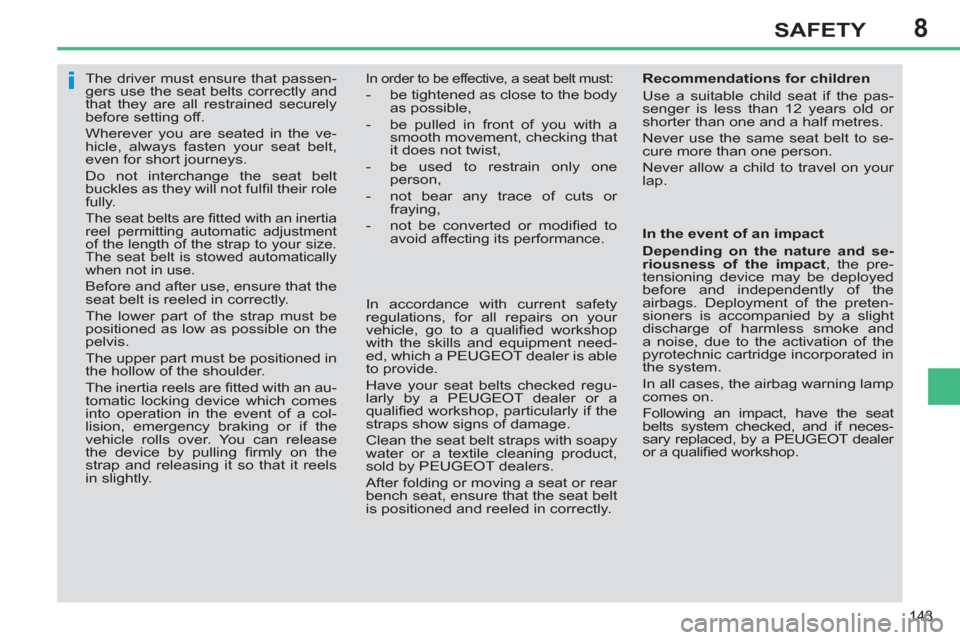
8
i
143
SAFETY
The driver must ensure that passen-
gers use the seat belts correctly and
that they are all restrained securely
before setting off.
Wherever you are seated in the ve-
hicle, always fasten your seat belt,
even for short journeys.
Do not interchange the seat belt
buckles as they will not fulfi l their role
fully.
The seat belts are fi tted with an inertia
reel permitting automatic adjustment
of the length of the strap to your size.
The seat belt is stowed automatically
when not in use.
Before and after use, ensure that the
seat belt is reeled in correctly.
The lower part of the strap must be
positioned as low as possible on the
pelvis.
The upper part must be positioned in
the hollow of the shoulder.
The inertia reels are fi tted with an au-
tomatic locking device which comes
into operation in the event of a col-
lision, emergency braking or if the
vehicle rolls over. You can release
the device by pulling fi rmly on the
strap and releasing it so that it reels
in slightly.
In order to be effective, a seat belt must:
- be tightened as close to the body
as possible,
- be pulled in front of you with a
smooth movement, checking that
it does not twist,
- be used to restrain only one
person,
- not bear any trace of cuts or
fraying,
- not be converted or modifi ed to
avoid affecting its performance.
In accordance with current safety
regulations, for all repairs on your
vehicle, go to a qualifi ed workshop
with the skills and equipment need-
ed, which a PEUGEOT dealer is able
to provide.
Have your seat belts checked regu-
larly by a PEUGEOT dealer or a
qualifi ed workshop, particularly if the
straps show signs of damage.
Clean the seat belt straps with soapy
water or a textile cleaning product,
sold by PEUGEOT dealers.
After folding or moving a seat or rear
bench seat, ensure that the seat belt
is positioned and reeled in correctly.
Recommendations for children
Use a suitable child seat if the pas-
senger is less than 12 years old or
shorter than one and a half metres.
Never use the same seat belt to se-
cure more than one person.
Never allow a child to travel on your
lap.
In the event of an impact
Depending on the nature and se-
riousness of the impact
, the pre-
tensioning device may be deployed
before and independently of the
airbags. Deployment of the preten-
sioners is accompanied by a slight
discharge of harmless smoke and
a noise, due to the activation of the
pyrotechnic cartridge incorporated in
the system.
In all cases, the airbag warning lamp
comes on.
Following an impact, have the seat
belts system checked, and if neces-
sary replaced, by a PEUGEOT dealer
or a qualifi ed workshop.
Page 159 of 356
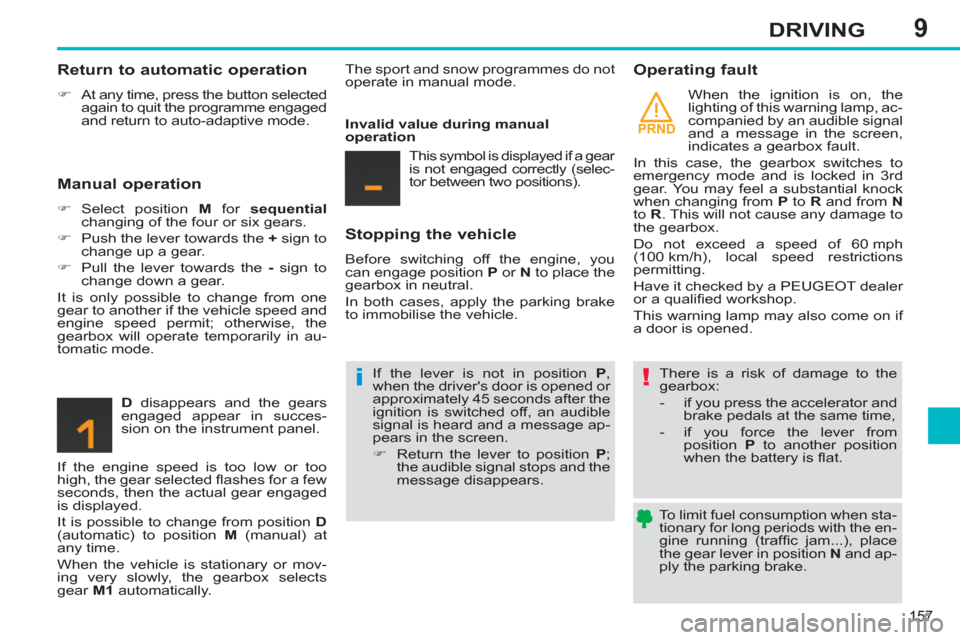
9
PRND
!i
157
DRIVING
To limit fuel consumption when sta-
tionary for long periods with the en-
gine running (traffi c jam...), place
the gear lever in position N
and ap-
ply the parking brake.
Return to automatic operation
�)
At any time, press the button selected
again to quit the programme engaged
and return to auto-adaptive mode.
Manual operation
�)
Select position M
for sequential
changing of the four or six gears.
�)
Push the lever towards the +
sign to
change up a gear.
�)
Pull the lever towards the -
sign to
change down a gear.
It is only possible to change from one
gear to another if the vehicle speed and
engine speed permit; otherwise, the
gearbox will operate temporarily in au-
tomatic mode.
D
disappears and the gears
engaged appear in succes-
sion on the instrument panel.
If the engine speed is too low or too
high, the gear selected fl ashes for a few
seconds, then the actual gear engaged
is displayed.
It is possible to change from position D
(automatic) to position M
(manual) at
any time.
When the vehicle is stationary or mov-
ing very slowly, the gearbox selects
gear M1
automatically. The sport and snow programmes do not
operate in manual mode.
Invalid value during manual
operation
This symbol is displayed if a gear
is not engaged correctly (selec-
tor between two positions).
Stopping the vehicle
Before switching off the engine, you
can engage position P
or N
to place the
gearbox in neutral.
In both cases, apply the parking brake
to immobilise the vehicle.
If the lever is not in position P
,
when the driver's door is opened or
approximately 45 seconds after the
ignition is switched off, an audible
signal is heard and a message ap-
pears in the screen.
�)
Return the lever to position P
;
the audible signal stops and the
message disappears.
Operating fault
When the ignition is on, the
lighting of this warning lamp, ac-
companied by an audible signal
and a message in the screen,
indicates a gearbox fault.
In this case, the gearbox switches to
emergency mode and is locked in 3rd
gear. You may feel a substantial knock
when changing from P
to R
and from N
to R
. This will not cause any damage to
the gearbox.
Do not exceed a speed of 60 mph
(100 km/h), local speed restrictions
permitting.
Have it checked by a PEUGEOT dealer
or a qualifi ed workshop.
This warning lamp may also come on if
a door is opened.
There is a risk of damage to the
gearbox:
- if you press the accelerator and
brake pedals at the same time,
- if you force the lever from
position P
to another position
when the battery is fl at.
Page 160 of 356
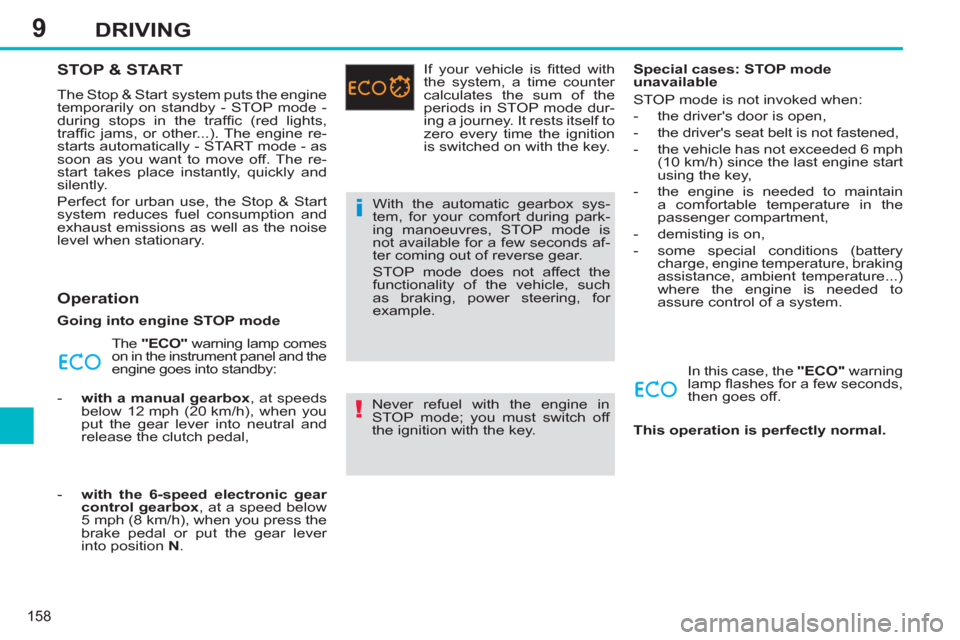
9
!
i
158
DRIVING
STOP & START
The Stop & Start system puts the engine
temporarily on standby - STOP mode -
during stops in the traffi c (red lights,
traffi c jams, or other...). The engine re-
starts automatically - START mode - as
soon as you want to move off. The re-
start takes place instantly, quickly and
silently.
Perfect for urban use, the Stop & Start
system reduces fuel consumption and
exhaust emissions as well as the noise
level when stationary.
Operation
Going into engine STOP mode
The "ECO"
warning lamp comes
on in the instrument panel and the
engine goes into standby:
- with a manual gearbox
, at speeds
below 12 mph (20 km/h), when you
put the gear lever into neutral and
release the clutch pedal,
- with the 6-speed electronic gear
control gearbox
, at a speed below
5 mph (8 km/h), when you press the
brake pedal or put the gear lever
into position N
. If your vehicle is fi tted with
the system, a time counter
calculates the sum of the
periods in STOP mode dur-
ing a journey. It rests itself to
zero every time the ignition
is switched on with the key.
With the automatic gearbox sys-
tem, for your comfort during park-
ing manoeuvres, STOP mode is
not available for a few seconds af-
ter coming out of reverse gear.
STOP mode does not affect the
functionality of the vehicle, such
as braking, power steering, for
example.
Never refuel with the engine in
STOP mode; you must switch off
the ignition with the key.
Special cases: STOP mode
unavailable
STOP mode is not invoked when:
- the driver's door is open,
- the driver's seat belt is not fastened,
- the vehicle has not exceeded 6 mph
(10 km/h) since the last engine start
using the key,
- the engine is needed to maintain
a comfortable temperature in the
passenger compartment,
- demisting is on,
- some special conditions (battery
charge, engine temperature, braking
assistance, ambient temperature...)
where the engine is needed to
assure control of a system.
In this case, the "ECO"
warning
lamp fl ashes for a few seconds,
then goes off.
This operation is perfectly normal.
Page 202 of 356
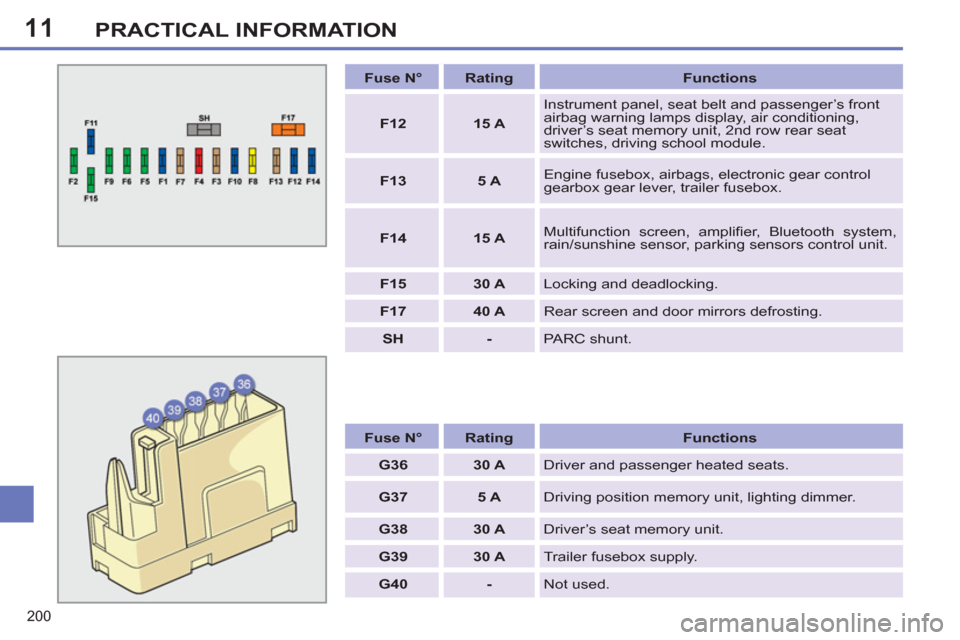
11
200
PRACTICAL INFORMATION
Fuse N°
Rating
Functions
G36
30 A
Driver and passenger heated seats.
G37
5 A
Driving position memory unit, lighting dimmer.
G38
30 A
Driver’s seat memory unit.
G39
30 A
Trailer fusebox supply.
G40
-
Not used.
Fuse N°
Rating
Functions
F12
15 A
Instrument panel, seat belt and passenger’s front
airbag warning lamps display, air conditioning,
driver’s seat memory unit, 2nd row rear seat
switches, driving school module.
F13
5 A
Engine fusebox, airbags, electronic gear control
gearbox gear lever, trailer fusebox.
F14
15 A
Multifunction screen, amplifi er, Bluetooth system,
rain/sunshine sensor, parking sensors control unit.
F15
30 A
Locking and deadlocking.
F17
40 A
Rear screen and door mirrors defrosting.
SH
-
PARC shunt.
Page 212 of 356

11
i
!
210
PRACTICAL INFORMATION
�)
On the rear bumper, unclip the cover
by pressing it on the left.
�)
Screw the towing eye in fully.
�)
Install the towing bar.
�)
Switch on the hazard warning lamps
on both vehicles.
�)
Move off gently and drive slowly for
a short distance only.
Towing another vehicle
TOWING A TRAILER, A
CARAVAN, ETC.
Your vehicle is primarily designed for
transporting people and luggage, but it
may also be used for towing a trailer.
Driving advice
Side wind
�)
Take into account the increased
sensitivity to side wind.
Cooling
Towing a trailer on a slope increases
the temperature of the coolant.
Towbar suitable for the attachment of a
trailer or caravan with additional lighting
and signalling.
Distribution of loads
�)
Distribute the load in the trailer so
that the heaviest items are as close
as possible to the axle and the nose
weight approaches the maximum
permitted without exceeding it.
Air density decreases with altitude, thus
reducing engine performance. Above
1 000 metres, the maximum towed load
must be reduced by 10 % for every
1 000 metres of altitude.
Refer to the "Technical Data" section for
details of the weights and towed loads
which apply to your vehicle. Driving with a trailer places greater de-
mands on the towing vehicle and the
driver must take particular care.
We recommend the use of genuine
PEUGEOT towbars and their har-
nesses that have been tested and
approved from the design stage of
your vehicle, and that the fi tting of the
towbar is entrusted to a PEUGEOT
dealer or a qualifi ed workshop.
If the towbar is not fi tted by a
PEUGEOT dealer, it is imperative
that it is fi tted in accordance with
the vehicle manufacturer's instruc-
tions.
If your vehicle is fi tted with the
1.6 litre THP 200 hp engine, you
cannot fi t a towbar. The space
occupied by the sport exhaust sys-
tem prevents this.
Page 213 of 356
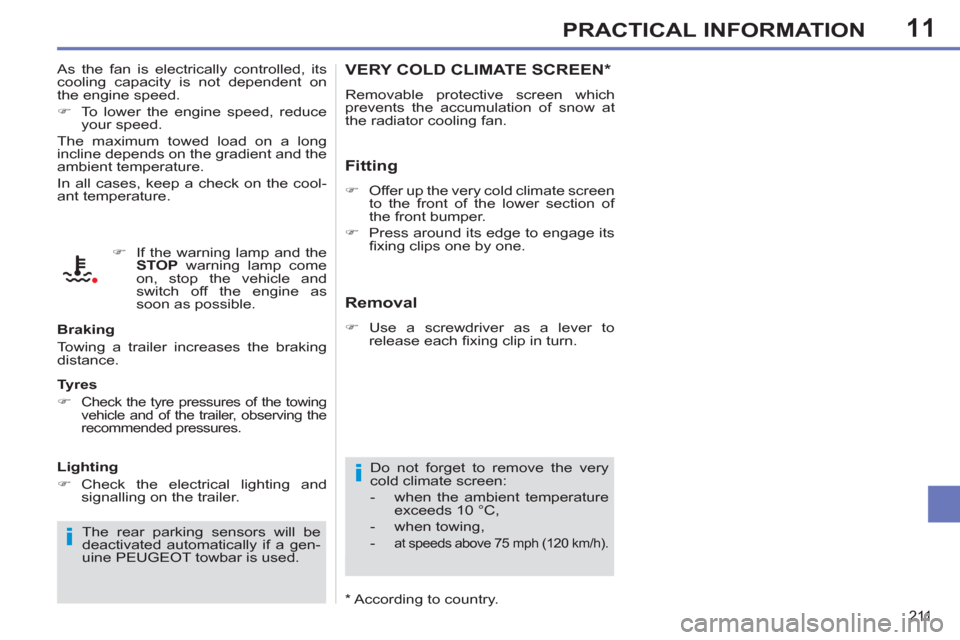
11
i
i
211
PRACTICAL INFORMATION
VERY COLD CLIMATE SCREEN *
Removable protective screen which
prevents the accumulation of snow at
the radiator cooling fan.
Fitting
�)
Offer up the very cold climate screen
to the front of the lower section of
the front bumper.
�)
Press around its edge to engage its
fi xing clips one by one.
Do not forget to remove the very
cold climate screen:
- when the ambient temperature
exceeds 10 °C,
- when towing,
-
at speeds above 75 mph (120 km/h).
Removal
�)
Use a screwdriver as a lever to
release each fi xing clip in turn. As the fan is electrically controlled, its
cooling capacity is not dependent on
the engine speed.
�)
To lower the engine speed, reduce
your speed.
The maximum towed load on a long
incline depends on the gradient and the
ambient temperature.
In all cases, keep a check on the cool-
ant temperature.
Braking
Towing a trailer increases the braking
distance.
Tyres
�)
Check the tyre pressures of the towing
vehicle and of the trailer, observing the
recommended pressures.
Lighting
�)
Check the electrical lighting and
signalling on the trailer.
The rear parking sensors will be
deactivated automatically if a gen-
uine PEUGEOT towbar is used.
�)
If the warning lamp and the
STOP
warning lamp come
on, stop the vehicle and
switch off the engine as
soon as possible.
*
According to country.
Page 220 of 356

12
218
TECHNICAL DATA
*
The weight of the braked trailer can be increased, within the GTW limit, if the GVW of the towing vehicle is reduced by an
equal amount; warning, towing using a lightly loaded towing vehicle may have an adverse effect on its road holding.
The GTW and towed load values indicated are valid up to a maximum altitude of 1 000 metres; the towed load mentioned
must be reduced by 10 % for each additional 1 000 metres of altitude.
The speed of a towing vehicle must not exceed 60 mph (100 km/h) (comply with the legislation in force in your country).
High ambient temperatures may result in a reduction in the performance of the vehicle to protect the engine; if the ambient
temperature is above 37 °C, limit the towed load.
WEIGHTS AND TOWED LOADS (in kg)
Petrol engines
1.4 litre VTi
98 hp
1.6 litre 16V
110 hp
1.6 litre VTi 120 hp
Gearboxes
Manual
Manual
Manual
Automatic
Model codes:
4C...
8FR-0
N6A-C
N6A-5
-
5FS-0
-
5FS-9
- Unladen weight
1 271
1 302
-
1 287
-
1 312
- Kerb weight
1 346
1 377
-
1 362
-
1 387
- Payload
509
518
-
528
-
523
- Gross vehicle weight (GVW)
1 780
1 820
-
1 815
-
1 835
- Gross train weight (GTW)
on a 12% gradient
2 980
3 020
-
3 315
-
3 085
- Braked trailer (within GTW limit)
on a 10% or 12% gradient
1 200
1 200
-
1 500
-
1 250
- Braked trailer * (with load transfer
within the GTW limit)
1 450
1 450
-
1 500
-
1 500
- Unbraked trailer
670
685
-
680
-
690
- Recommended nose weight
60
60
-
76
-
60
Page 221 of 356

12
219
TECHNICAL DATA
WEIGHTS AND TOWED LOADS (in kg)
Petrol engines
1.6 litre THP
150 hp
1.6 litre THP 156 hp
1.6 litre THP
163 hp
1.6 litre THP
200 hp
Gearboxes
Automatic
Manual
Automatic
Automatic
Manual
Model codes:
4C...
5FE-J
5FV-8
5FV-A
5FM-J
5FU-8
- Unladen weight
1 358
1 315
1 368
1 358
1 399
- Kerb weight
1 433
1 390
1 443
1 433
1 474
- Payload
502
525
502
502
451
- Gross vehicle weight (GVW)
1 860
1 840
1 870
1 860
1 850
- Gross train weight (GTW)
on a 12% gradient
2 660
3 390
3 470
2 660
1 850
- Braked trailer (within GTW limit)
on a 10% or 12% gradient
800
1 550
1 600
800
X
- Braked trailer * (with load transfer
within the GTW limit)
800
1 650
1 650
800
X
- Unbraked trailer
710
695
720
710
X
- Recommended nose weight
65
70
70
65
X
The GTW and towed load values indicated are valid up to a maximum altitude of 1 000 metres; the towed load mentioned
must be reduced by 10 % for each additional 1 000 metres of altitude.
The speed of a towing vehicle must not exceed 60 mph (100 km/h) (comply with the legislation in force in your country).
High ambient temperatures may result in a reduction in the performance of the vehicle to protect the engine; if the ambient
temperature is above 37 °C, limit the towed load. *
The weight of the braked trailer can be increased, within the GTW limit, if the GVW of the towing vehicle is reduced by an
equal amount; warning, towing using a lightly loaded towing vehicle may have an adverse effect on its road holding.